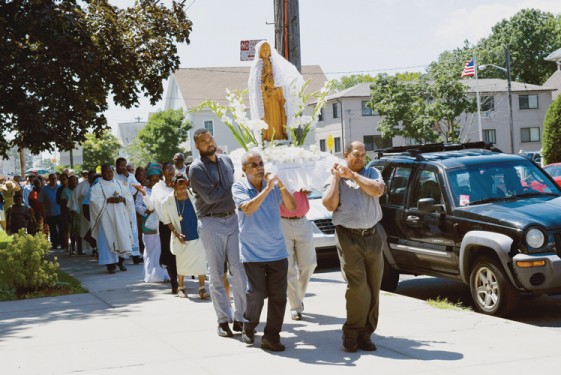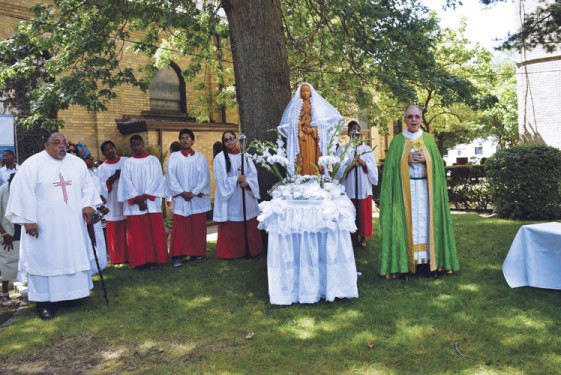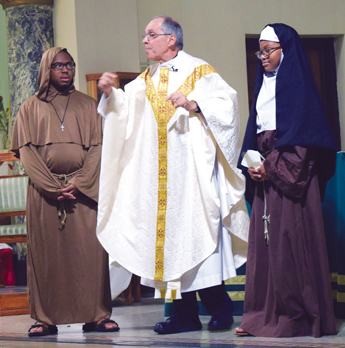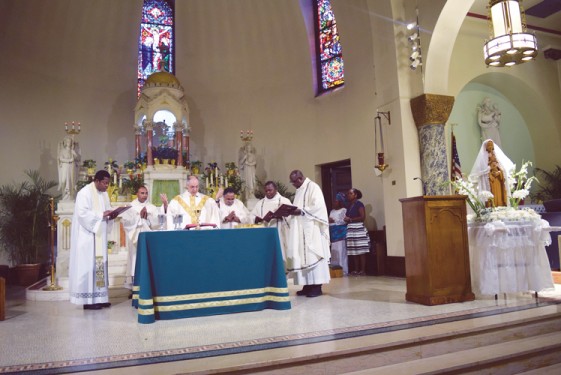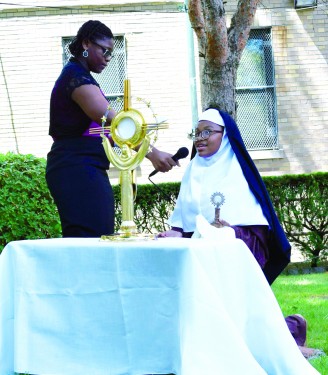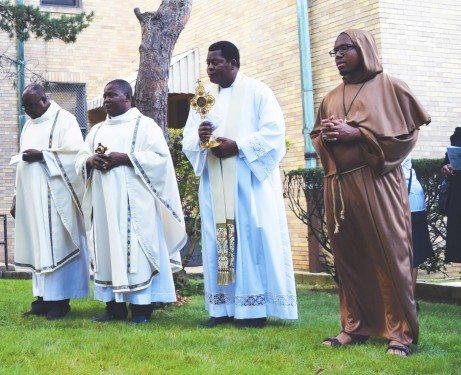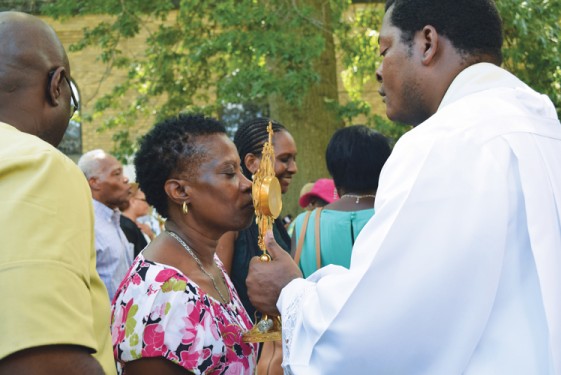By Antonina Zielinska
Dunking the pastor in a pool of cold water, a living scene of a teenager in a habit on her knees in front of a monstrance and people gleefully singing a litany to St. Clare outside in the noontime sun despite a citywide heat warning were all activities organized by St. Clare parish to celebrate its patroness.
In previous years, the Rosedale parish held Masses for its feast day on the day it actually fell on, usually a weekday, making it difficult for working adults and families to be in attendance.
This year, the parish council decided that it wanted to highlight its patroness and extend the festivities into the weekend.
The parish hosted a festival on Saturday, Aug. 13, complete with a bouncy house, Curry-Q and BBQ. Live music and games entertained parishioners of all ages and the pastor was in for a surprise.
[story continues below]
Baptized Again
Father Andrew Struzzieri was sitting above the dunk pool while a young parishioner was not having much luck hitting the ball on the target. So he started speaking with a woman nearby, when he suddenly felt instant relief from the scorching heat.
“It felt like I was getting baptized again,” he said.
The next day was dedicated to the spiritual aspect of the saint’s life. A celebratory Mass followed the feast day readings and Father Struzzieri gave a homily highlighting St. Clare’s life.
Lessons for Today
The 13th-century saint was born into a rich Italian family, expected to enjoy the finer things in life and marry a man worthy of her station. She was known to have been beautiful with gorgeous hair and clothing to match.
Despite the riches that surrounded them, her mother was known for her devotion to the faith.
Then during lent, when she was 18-years-old, St. Clare heard another saint, Francis of Assisi, speak about living in poverty of spirit, entrusting everything to God. The friar touched the young women’s heart so profoundly that it not only changed the course of her life, but the course of history.
“She decided right there and then to devote herself to a spirit of poverty,” Father Struzzieri pointed out during his homily.
“And now, girls her age at that time did not decide anything; their father decided for them.”
Accepted Poverty
St. Clare returned to speak with St. Francis clandestinely on Palm Sunday, accompanied by her aunt. At that time to show her devotion to a life of poverty, she let St. Francis cut her hair and accepted clothes of poverty and a habit.
When her father came to bring her back home, the young women refused so profusely that she held the alter as he tried to drag her away and finally convinced him of her devotion when she removed her habit to reveal her cut hair.
A few days later, her sister, St. Agnes joined her. Their father and relatives were so infuriated that St. Agnes was beat to near death before a miracle happened to help her escape.
With the guidance of St. Francis, St. Clare started the cloistered Order of Poor Ladies, later known at the Poor Clares, as the second order of Franciscans. She was so devoted to absolute poverty and the spirit of St. Francis’ spiritual life that this poor nun stood up to even popes to retain her community’s spirituality.
In the absence of St Francis, the protector of the order, Cardial Ugolino who would become Pope Gregory IX, codified the order’s rule after St. Benedict. The new rule, if not by intent than by effect, took away the Clares’ and Franciscans’ character of absolute poverty. This was approved by Pope Honorius III.
The Clares’ and Franciscans’ adhered to absolute poverty, owning nothing, not even in common, relying on what the friars minor could gain from begging. Cardinal Ugolino thought this impractical for cloistered women.
However, St. Clare was finally able to convince Pope Gregory IX of the merits of such a life when he returned to Assisi to canonize St. Francis. He finally passed a rule forbidding anyone from coercing them to take on possessions. This rule was the first of its kind ever sought or ever received by the Holy See.
Absolute Trust
St. Clare’s absolute trust in God is most represented in statues depicting her holding a monstrance. This is a reference to a miracle that saved her city on her intersession.
The southern king of Italy, Frederick II, wanted to spread his dominion and so sent soldiers to attack Assisi by scaling the walls of San Damian. St. Clare, rising from her sick-bed, took a ciborium containing the Living God out to meet the soldiers in prayer. The soldiers retreated and the city was saved.
Among other things, St. Clare is the patroness of television because when she was too sick to attend Mass she was said to be able to see and hear the Mass on her wall.
To acknowledge the many virtues of St. Clare, the Rosedale parishioners took to the street to praise her in litany in a procession. They were accompanied by four relics of the saint, two of her bones and two of her hair, which are nearly 800 years old.
Then parishioners gathered in the church garden to see a short dramatization of her life performed by teens in the parish.
Admar Charles, 14, played the role of St. Francis. His mother Addly Labatte. Prepared the costumes, and his aunt, Dedzy Labatte, wrote the script.
Inspirational Effect
Charles said he felt blessed to be able to play St. Francis because he thinks it can have an inspirational effect on parishioners when they see youth engaged in church activities.
Deina Felix, 15, played St. Clare and Tiffany Cayke-Okpuzor, 15, served as narrator.
“St. Clare is our patroness and we have to make sure [parishioners] are aware of it,” said Cayke-Okpuzor.
“Young women look to movies and magazines for role models. They should look to the church instead and St. Clare is a perfect example of that.”

